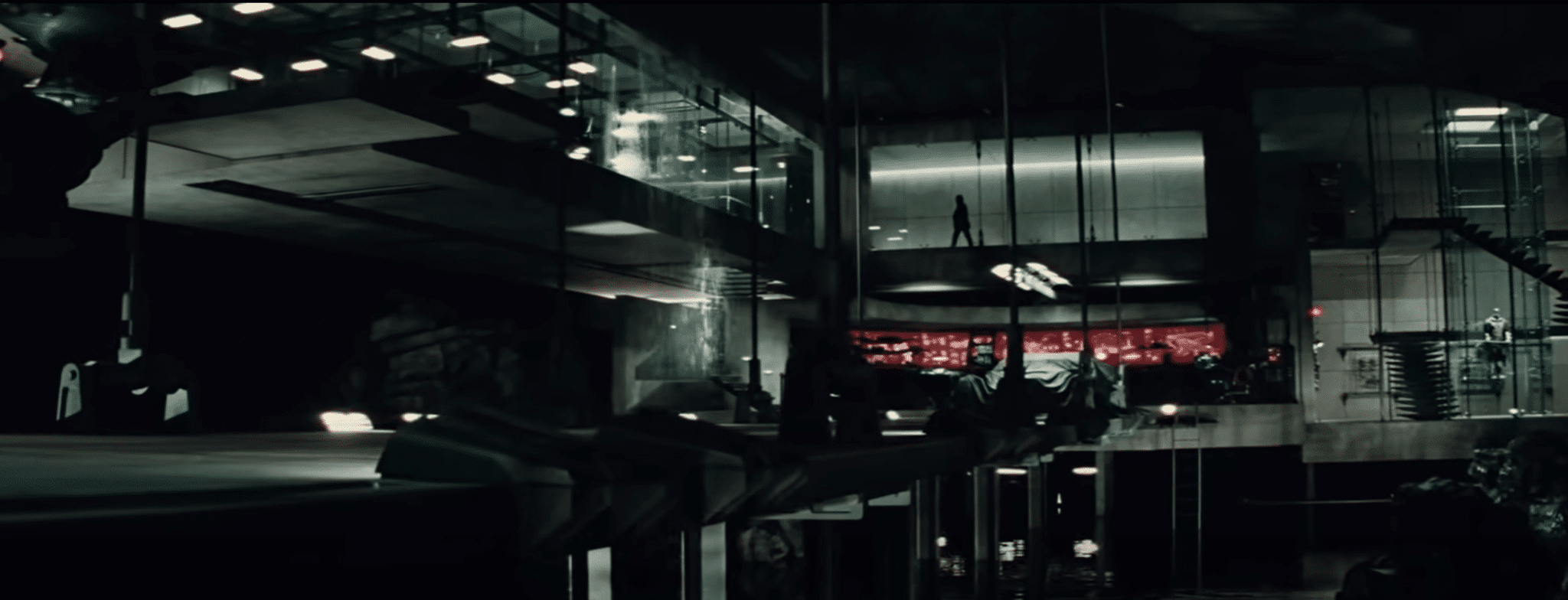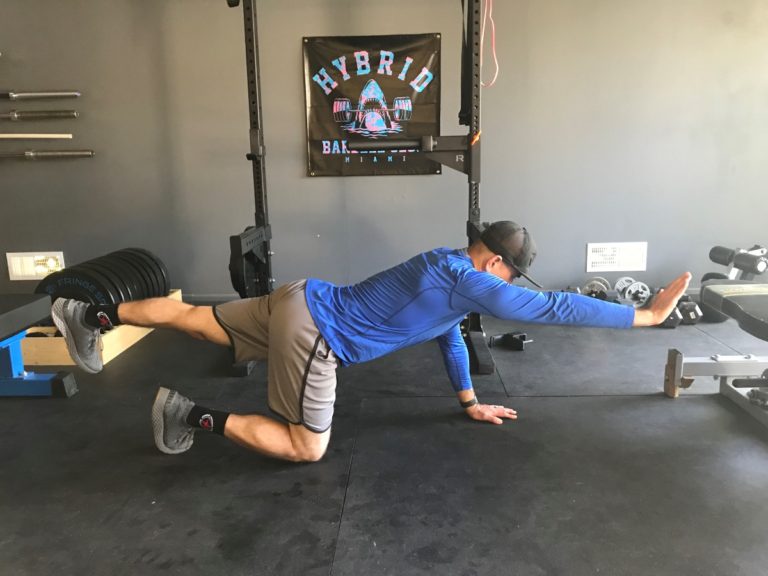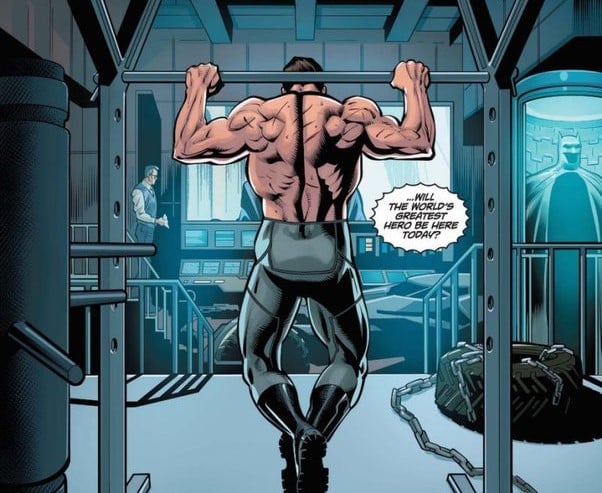Workflow, Vertical Storage, and the Home Office: Batfleck's Batcave, Article #7
Welcome back readers, to this latest installment in the Batfleck Batcave series! If this is your first time here, might I suggest you start with the first Batcave installment here. It’ll get you up to speed and give you all the context you need to begin working on your own unique workspace, man cave, she shed, or work from home office. In other words- Your Own Batcave!
This article will give some practical ideas to consider with your Batcave, as we look through the lense of How. We’re gonna get into the nuts and bolts of how to better organize all the various items in your chosen area. This will help you make it the very best, most productive workspace you’d ever want. And if all you want is your own Batcave Man Cave there are some ideas for that too. Let’s get into it.
Workflow and Logistical Considerations
Optimizing the process you follow when completing a task is crucial in improving your efficiency but is often overlooked. With so many inputs coming at us all the time, it’s easy to become distracted with our impulse to complete the work as soon as possible. As a result, we often lose sight of how we’re completing the work.
This process is known as workflow. Ideally, you want each step of your task process to logically lead to the next. The optimal workflow ensures needed items and equipment are near to each other and is therefore efficient, both in time and energy saved. For each subject and task you’re going to complete, you’ll want to look at the steps you naturally take, and consider if there are ways to improve this process. It often helps to write out the sequence of steps.
As an example, let’s consider the workflow of someone designing and creating products using a 3D printer. Most likely, if I was going to attempt this, I’d utilize an interior room (as opposed to an outdoor shed) in my house, maybe a spare bedroom. I walk into the room and move to the desk, which is just inside on the left. Here at the computer, I can research products I’m interested in creating, see if there are files available online, get inspiration, and maybe design products using whatever software is appropriate for my printer.
The desk area is going to be the starting place for many of us. Whether we’re researching something, writing, etc. the computer is likely where we’re going to start. Next, I might move to the cart or shelf where the 3D printer is stored. This should be located directly next to the desk, or on the adjacent wall. I don’t need to walk across the room to begin printing items when it saves time and effort to stand up and just turn towards the next step in my process.
After the machine is finished printing my item, or maybe multiple items, what is the next step? Perhaps I immediately start stacking and storing the items on a storage shelf. Then I move down the room to the work table, where I can grab items from the storage shelf and begin packaging them for shipment. This might make sense if I’ve printed say a hundred items or so. If I’ve only printed a few, it probably makes more sense to skip the storage part and go straight to prepping them to mail.
The point in all this is that you’re not zigzagging all around the room from step to step. Making the process consistent and repeatable helps. All items for each step are located where that step happens. As you move through the steps, the process flows easily. Even 10 seconds saved starts to add up across a hundred or more products!
Depending on your particular work, you can scale this thought process up or down. What is your sequence of tasks on the computer, solely? Would having a second monitor improve things? What about a tablet that you can use as a reference source to take from the desk to wherever else you might need to go? If we zoom out, what is your workflow across your day?

Most of the above assumes that you’re working out of one room. If you’re like Bruce Wayne and you’re utilizing multiple rooms, such as he does when he creates the kryptonite javelin, then you’ll need to consider not only workflow but how you’re moving yourself and your equipment between rooms and locations. This is something referred to as logistics.
In terms of how the Batfleck Batcave is laid out, you’ll notice that the cubes are situated around the Batmobile turntable, which acts as the focal point for the entire cave. If Batman needs to quickly bug out for a mission, then he’s only one room removed from his vehicle at all times (within the Batcave at least). Any heavy equipment he might need is stored in the garage/mechanical section, and if he needs to arm up with specific personal gear, the Armory is directly adjacent to the garage.
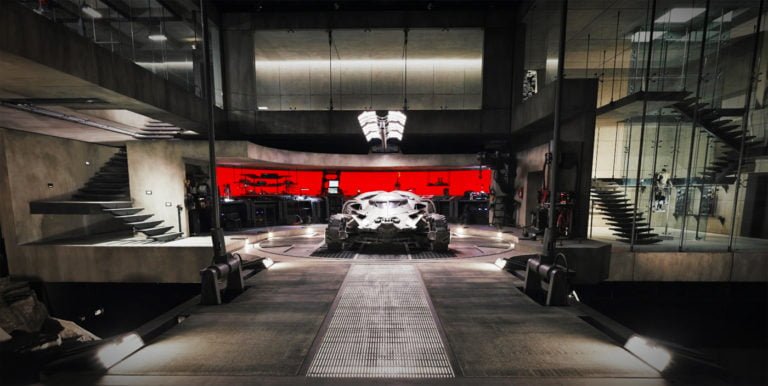
This hub and spoke-like design is used often in cities and is a time tested way of organizing spaces. For your own home and the workspaces contained there, you’ll want to consider your daily routine(s) and what workflow makes sense most of the time. Luckily, there are online tools that can help you visualize and improve the flow of your workspace, as sometimes it’s difficult for us to think outside of what we’re used to.
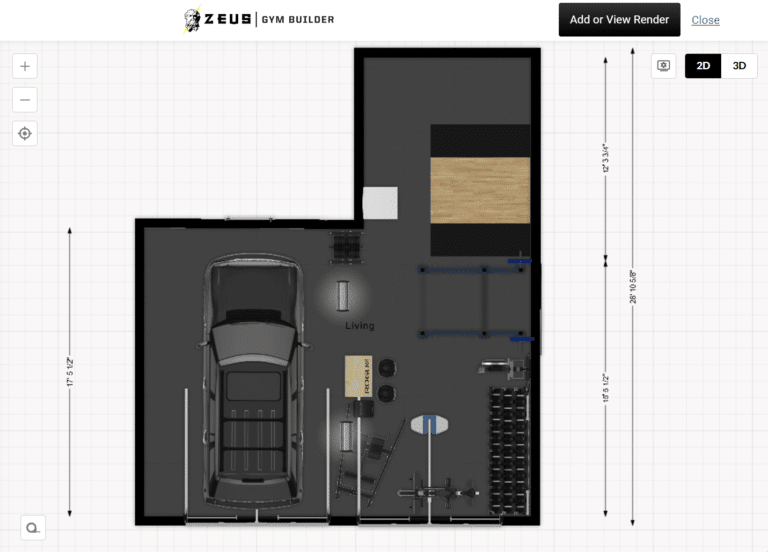
Room Sketcher (no affiliation) is a nice design app you can use for desktop or tablet. You can create a free account, design things yourself form scratch or a template, or purchase designs from other users. Similarly, Rogue Fitness also offers the Zeus Gym Builder on its website, for quick n easy home gym design.
These tools are useful because you can enter in all the dimensions of your space and the equipment it’s going to contain. This gives you a more accurate view of how you’ll move through the space (and even if you’ll have enough space!). For instance, the white square in front of the platform above is a refrigerator, which just leaves room for a walkway in between.
Workflow is such a broad topic it could easily sustain its own dedicated article. And while you could get caught up in the many process theories surrounding it, if you simply take the time to think about how you move through your tasks you’ll be well on your way to improving the overall functionality of your space(s).
Materials Used
In addition to workflow you’ll want to consider which materials you want to dominate your space. Obviously aethestics are something to consider, especially if you’re really going for a Batman Batcave vibe. However, things like strength, durability, and workability (if you’re going to be making things yourself) are important as well. As covered in the first article, Batman makes frequent use of steel, glass, and concrete, so if you have any or all of these materials in your space it’s going to help give it the industrial look so heavily associated with the Batcave. Below are some materials to consider and a few of their relevant characteristics.
Steel
Steel is one of the strongest, most resilient materials you could choose for your space. This can come in the form of a steel desk or work table as the centerpiece of your work from home office or workshop. Particularly if your work is going to be hard on the surface, or if it’s messy, this is a good choice as steel will hold up over time and is easy to clean. That’s not to say that a steel table can’t receive some surface level damage, but I feel that any scratches, dents, or changes in color tend to enhance the look of such an item over time.
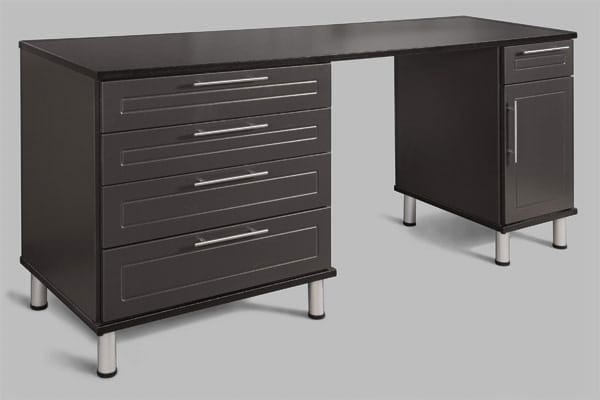
For storage considerations, steel cabinets and tool chests look really great, no matter if you stick them in the garage or in your hobby room. They range widely in price, from your local hardware store brands (Husky, Craftsman) to more upscale, pro mechanic oriented brands like Snap On. There are no shortage of die hard fans for either of these price points that will swear up and down either that one is a better value, or “you get what you pay for.” Do your own research to find the combination of value to price ratio that works for you. Additionally, make sure to note the recommended weight capacity for any drawers/drawer slides if what you’re storing is heavy.
If you’re putting together a gym or even if you just want a single piece of gym kit in your space, steel is the default choice. Not all steel is created the same though. The default thickness and quality of steel used in power racks, as seen from Rogue Fitness and others, is 11 gauge steel. This is plenty strong for most gym applications. If you want something even beefier you’ll want to look for a lower numbered steel, as in this case the lower the number the thicker (and stronger) the steel.
If you live in a humid climate or a coastal area and you have the money, it might be worth investing in a stainless steel rack. Although these are expensive, stainless steel is going to be the best at resisting rust and corrosion. With gym equipment as well as other steel items, there are many different finishes to consider. Again, do your research on this, but generally speaking, Cerakote does a good job of protecting material as long as your equipment isn’t going to rub up against things too much. This can wear the Cerakote finish off of the steel.
Glass
At the other end of the spectrum from steel, we have glass. What it lacks in durability it makes up for with its ability to open up a space and offer a different form of functionality, namely transparency. When Batman arrives back from a mission, he can easily glance up into the Armory and the Lab to see the progress of a build, check Alfred’s whereabouts, or view other important details. This is an essential compensation to the single room = single task way of organizing the Batcave, and prevents Bruce from getting tunnel vision.
If steel isn’t appropriate for your space, cost is a consideration, or if you just don’t need the durability, consider glass as an option. Desks or tables with glass tops offer an excellent writing surface and still lend an industrial vibe. Cabinets with glass fronts allow one to view the state of items (maybe something needs replacing or replenishing) and can also inspire you by putting items on display that you may not have otherwise considered for your project.
Concrete
Batman utilizes concrete for the floor and ceiling surfaces in the Batcave. You may not have this option, but there are still some ways to bring this material into your space. Although not as common as some other materials, there are many videos on YouTube and articles on the net demonstrating how to work with concrete. It’s actually pretty easy. If you have a way to make a mold, either with lumber, flower pots, plastic bowls and bottles, etc, you can create something cool and functional with concrete. .
This article from DIY legend Bob Vila’s website, offers a few ideas, including bowls and votive holders, an iPad stand, and this really solid looking coffee table (see image above). If you decide to make something with a large surface area like a table top you’ll have to deal with the weight (hey, a built-in workout!). However, with concrete being so cost effective and easy to work with, it’s definitely a material worth considering.
Wood
No offense to the industrial options above, but far and away the easiest material to build with yourself is going to be wood. You can make nearly anything with wood if you have the right tools, so if you need a desk, table, cabinets, bookshelves, or even a squat rack(!) you can do it with wood. It’s strong, durable, and the look of it is highly customizable as well. If you aren’t completely married to the industrial look of Batman’s cave, this can be a great option, but even so you can probably achieve a similar look (you can paint it black or a very, very, very dark grey).
Admittedly, it’s not the bargain, fiscally speaking, that it used to be. However, what’s great about using wood, is that you can tailor it to the specific needs of your space. Some examples-
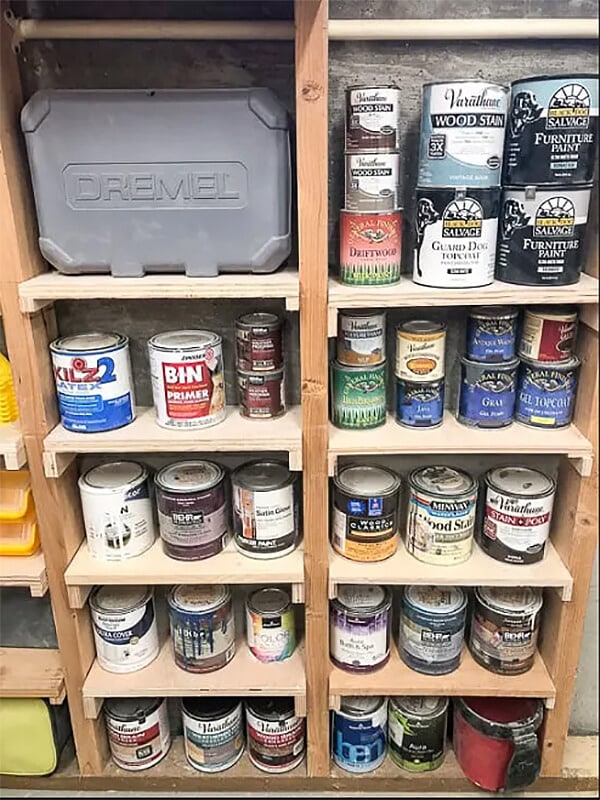
I like a few things about this example. One, is that they were able to utilize space that usually goes to waste, in this case the space in between studs in an unfinished basement. I also like that the shelving is very shallow. This is good in this case because all the paint and varnish cans are visible and accessible. No need to go digging behind the first row just to see what you’ve got. 👍
The above is another good example of customization. The builder was able to make a storage tower that fits this little corner nook exactly, in a way that maximizes the space but also prevents the tower from blocking the next wall over. Another thing about doing something like this is that you can plan out the spacing of your shelves so that they don’t block light switches or panels you may need to access.
I built the above bookshelf to fit our entryway. I often feel that bookshelves are made too deep, so if I needed to I could’ve customized this one to be more shallow. Since I had the space though, I just used the default plans which you can find here. I did add another tier of shelves to this, and although it’s far from perfect, it’s certainly functional. Annnnd, by now this bookcase is most definitely double-shelved, so I guess I ended up needing the extra depth anyway, lol.
Use of Vertical Space
Gym Considerations
One of the smartest things you can do to maximize the storage capacity of your space is to make use of vertical space. Take a page from Crossfit gyms around the world. They prioritize floor space, as many exercises from burpees to the Olympic lifts require an open, uncluttered floor area.
In the video above, (now former) Games competitor Kristi O’Connell and her husband Pat explain some of their thoughts on garage gym design. Starting at the 2:00 min mark, they speak about getting their weight plate storage up off of the floor and onto the walls. They also make use of vertical barbell storage and hooks to store ruck packs and bands.
Another interesting choice they’ve made that seems to be really working for them is the decision to go with the combo of a simple, moveable squat rack and a dedicated wall-mounted pull-up bar. When they don’t need the rack set up they can just move it under the pull-up bar or somewhere out of the way. Without a dedicated squat rack taking up a lot of floor real estate, it really opens up their garage gym visually and allows them to have an uncluttered space functionally.
Workshop Considerations
Consider Putting One of These in Your Batman Garage
It’s not just gyms that can benefit from this idea of moving storage to the walls. Car mechanics will often mount hose reels (air and pressure washer) on walls for garage efficiency. Artists and artisans mount spools of paper, thread, or other media on walls for easy retrievability. While these are some good examples that you can totally steal, maybe you can come up with something novel that works for your particular situation(?).
 As you can tell, I love vertical storage, but it’s not all good news. As you put more and more things on the wall, you’ll possibly create some drawbacks. For one, you may not be able to hang artwork, photography or reference resources on the wall. I have seen some libraries that have wall art hanging directly on the shelves (covering the books). This could be an acceptable compromise if you’re okay with the look.
As you can tell, I love vertical storage, but it’s not all good news. As you put more and more things on the wall, you’ll possibly create some drawbacks. For one, you may not be able to hang artwork, photography or reference resources on the wall. I have seen some libraries that have wall art hanging directly on the shelves (covering the books). This could be an acceptable compromise if you’re okay with the look.
Additionally, and maybe more of a concern, is that things can again start to look very cluttered the more you put on the walls. If any of your wall hung storage cabinets have doors to conceal their contents this will relieve some of the cluttered look. But even with this measure, walls can still start to look too full. It’s up to you to decide the balance of how much storage versus open space is right for your own workspace (and peace of mind!).
Declutter with Smart Storage Solutions
If you’ve already KonMari’d your workspace ala Article #5 in this series, then you’ve got the most essential work of decluttering done already. You know how and where to arrange the items in your space to achieve an optimal workflow. Now you just need to ensure that you have appropriate storage for the items you have left, while leaving a bit of room for your collected equipment to grow.
As mentioned throughout the series, Batman’s collection of equipment is highly curated. His storage solutions are as well. Here are some noteworthy organizational tools that crop up in the Batcave and some civilian equivalent options you might consider for your own space(s) to give you the functionality and industrial feel of the Batcave.
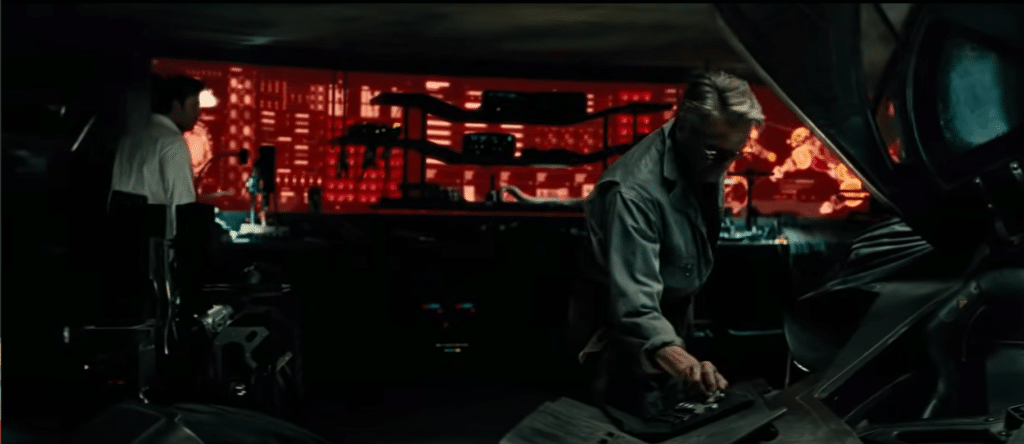
The below black metal wall shelving is unique and checks some of the boxes. However the storage capacity is not much, around 10-15 lbs, so steer clear if you need something more substantial.
If you do need something more beefy, you might consider high performance metal shelving from Diamond Life Gear. This heavy duty shelf will hold up to 150 lbs and comes fully assembled, no additional bracket needed.
Batcave Man Cave
Or, for really heavy duty applications you can repurpose a tire shelf (see below). These will hold up to 400 lbs, so you can rest assured they can handle your hobby gear as well.
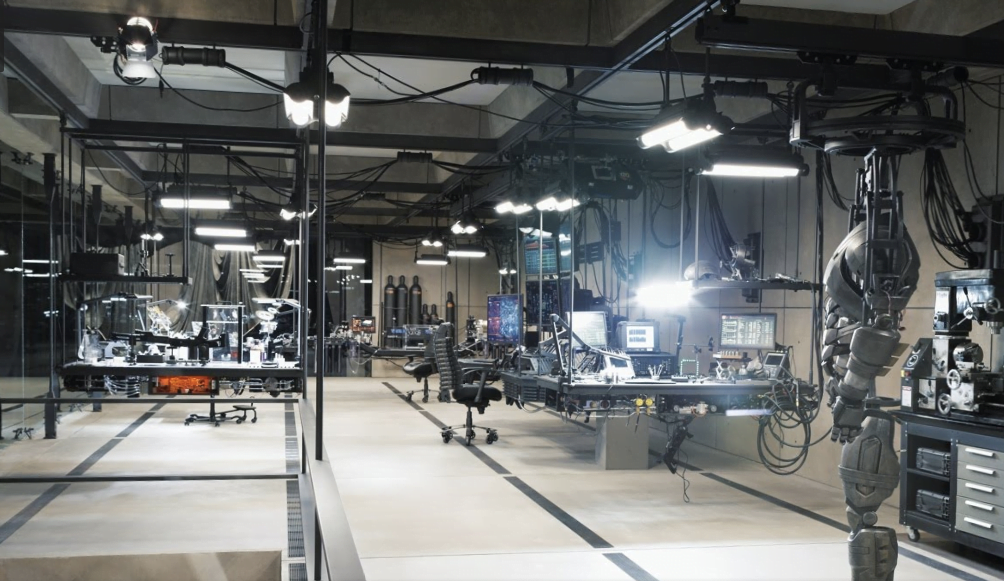
Giant fancy tool chests are awesome. But if you’re just getting started you can grab a single rolling tool cart like the Craftsman set below, or even just get the bottom half alone. A smaller tool cart such as this still gives you a good amount of storage to work with, plus it’s highly mobile and can follow you around your space with ease. If you had the need, you could outfit a few of these, each with the equipment specific to a certain task, such as one for car maintenance, one for general home maintenance, and one with smaller hiking/outdoor supplies. When the need arises, just pull out the cart that is specific to your task.

There are several options you can use to imitate the wire grid panels used in Batman’s Armory. First, you can acquire your own wire panels, which though they might not look exactly like the ones depicted in the movie, will still look great and do the job.
There’s something I like even better than wire grid panels though, and that’s the pegboard. But not just any ole pegboard. Wall Control metal pegboards are probably my favorite pegboard option. They are made of durable metal and come in a variety of colors. They’re highly customizable and can be used to organize your garage, your gym, your work from home office, or just about any hobby you could possibly think of. For the value and longevity they provide, the price is very affordable as well.
Here’s one other option for that Batcave inspired wall storage. If you want to go full out and maximize storage on the entire wall or most of it, you can go with the slat wall. Again, this option allows you to customize how you want to organize things with various accessory attachments available. This particular version is from Gladiator.
What's Next?
By now, if you’ve been following along, we’ve covered a lot of ground in thinking about our workspaces. We’ve done the work of purging them of unneeded junk, determined if our space should be single room or multi-room, and we’ve considered workflow, materials, and smart storage solutions.
When I watch the Batcave scenes from BvS, I’m always struck by a couple specific images that bring it altogether for me. Why does Bruce do what he does? After all is said and done, and we have our personal spaces just how we want them, we’re still going to have moments where we hesitate or procrastinate in performing our tasks. Addressing this point will be the topic of the next and very last installment of the Batcave series!

